In my last blog I provided some details about the seldom considered subject of cup grenade launchers. I promised to give a similar treatment to spigot launchers. I had intended to include rod grenades in that post, but instead have chosen to give this subject their own post. Since very few movies have been set in the trenches of the Great War, rod grenades are perhaps even less familiar to most people than other types of rifle grenade. The First World War as a genre is rather neglected, yet has potential for survival/ horror scenarios, if nothing else. 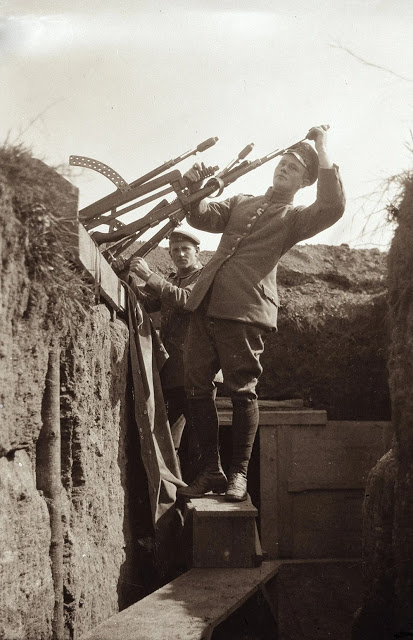

Rodded grenades were widely used during the First World War. The Germans entered the war with two models already adopted. German units were amply provided with these, so the grenades seem to have been in full-scale production. These proved to be a great and deadly nuisance to those they were used against. Around 1917, when cup dischargers became more common, German use of rodded designs declined. The British had no rod grenades in service at the start of the war, so developed a variety of models. Development continued until the end of the war and rodded designs remained in British service after cup dischargers became common.
As the name suggests, the rod grenade is a rifle grenade fitted with a long rod. The rod is inserted in the barrel of a rifle, and the grenade projected by firing a blank cartridge. While you will see the cartridges used to propel grenades called “blanks” it should be understood these are not the same as blank ammunition used for war games or TV shows. Using a normal blank with a rifle grenade (of any sort) will not get the grenade very far.
Many of the problems with firing grenades from cup dischargers were also true for rod grenades. Recoil damaged the furniture of the gun and affected the sights. Projectile flight was very susceptible to the influence of wind and other elements. Rodded grenades had some additional problems. The rod was effectively a barrel blockage so many rifles used for launching would succumb to bulged or burst barrels. Service rifles of the period were between 6.5mm and 8mm in calibre, necessitating that a rod be narrow. This, in turn, required the rod to be made of a relatively strong material if it was to avoid being easily bent or damaged. Damage to the rifling could occur, as could jammed rods.
Many of the practices later seen with cup dischargers had been developed for rodded grenades. Dedicated rifles, not used for normal shooting, were used as launchers, and weapons were fired with their butt against the ground, never from the shoulder. In the trenches launching rifles were often mounted in firing racks. Sometimes these were arranged to create a battery of several weapons, and a means to fire all at once improvised. Trench mortars, machine gun nests and suspected sniper positions were often targeted. While mainly used like short-range mortars, grenade launchers were also used in more mobile roles. Some manuals and books of the time recommend that trench bombing parties included rifle grenades as well as hand grenades.
In British service a rod could be between 5½ and 17½ inches long, certain lengths being preferred for different models of grenade. Rod length had an influence on gas pressure within the barrel, and hence launch velocity and range. Longer rods increased recoil, while shorter rods caused the barrel to split sooner due to a longer path for reflected pressure wave effects. Incidentally, rod grenades required a different type of blank cartridge to cup dischargers. The lower volume in the barrel required a fast-burning, high pressure load. Some designs had a copper cup or plug at the base that was intended to serve as a gas seal. In practice this may fail to expand or fracture, causing range discrepancies. The length of the rod made the grenades awkward to carry in action. A bent rod could not be used, and a rod should be dry and clean before being inserted in a barrel, which could be a problem on the Western front. 



Range of a rod grenade was determined by barrel angle. German grenades also used attached discs to increase drag. In summer 1917 the British adopted an additional technique. It was found a rubber ring could be added to the rod to limit how far it inserted down the barrel and thus vary the velocity. The downside was it became more likely for an unwieldy 15 inch rod to be fitted.
Explosive rod grenades were either time or impact-fused.
Ideally, the time fuse exploded as the grenade arrived at the target.
If it was late it might burst in mid-air with little or no effect.
An early round might bury itself in mud and thus throw few fragments.
Impact designs had their own problems. Impact with soft mud or snow might fail to detonate the grenade and bury it.
This is in fact a problem still encountered with modern grenade launcher rounds.
Many Great War impact designs were overly sensitive and might detonate prematurely in mid-air. Worse, some would detonate on firing! The chance of the No.22 detonating in the launcher is reported as high as 2%!
Many grenadiers during WW1 mounted their launcher on a rack and fired it with a lanyard from behind cover.
One presumes the No.22 was not suited to mobile operations such as trench-bombing raids.
At the start of World War One a British infantry platoon consisted of four rifle sections. By mid-1916 each section had specialized.
The mid-1916 platoon had a rifle section, a section supporting a Lewis Gum team, a “bomber” section specilizing in hand grenades and a rifle-grenade section with eight rifle grenadiers. organized as a single section.
By late 1918, the platoon had restructured to have two Lewis gun sections and two rifle sections. The rifle sections carried rifle and hand grenades.



Eventually, a number of relatively useful designs saw widescale use with the British Army.
The No.22 “Newton Pippin” was an impact-fused model. Its cone-like shape ensured that it arrived nose first. The fuse was noted for its “instantaneous” action. It would detonate on the surface of mud rather than within it and creating a crater. Fired against masses of barbed wire it would damage the wire, something much larger artillery shells often failed to do. Consequently, the fuse was adapted to use with mortar rounds for use against wire obstacles.
At 1 to 1.63 lb, the No.22 was relatively light and could be launched at around 67 yd/s to 300 yd. It used a 15 inch rod with a copper gas seal. Depending on how the gas seal behaved, maximum range might be as low as 220 yd or up to 350 yds.
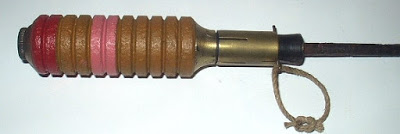
The No.20 (above) can be used for a more conventional British impact-fused rod grenade and to represent later evolutions such as the No.24 and 35. Weight 1.38 lb, 10 inch rod, 250 yds. For the earlier No.3 reduce range to 185 yd.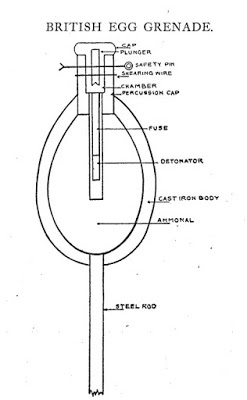

The No.34 “British Egg” hand grenade mentioned in the cup discharger blog could also be used as a rodded grenade. The only modification needed was to screw a rod to the grenade.
As with cup launching, there was no need to strike the cap. If the safety pin had been removed, the acceleration of launch was enough to shear the wire and start the seven second fuse.
The same igniter was used in the No.27 rifle grenade, a rodded WP grenade. Rod launch was used for smoke and signalling grenades as well as anti-personnel. Rodded grenades were used to pass written messages between positions, although some of these message carriers may have been grenades emptied of fuse and explosive. 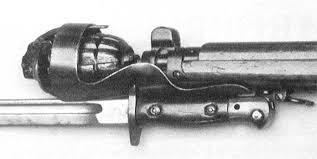
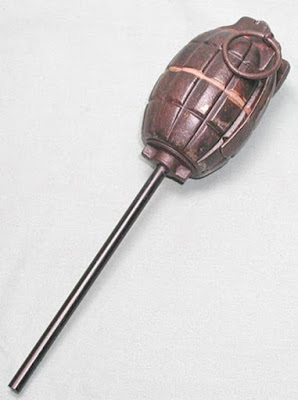


The No.23 version (1.53 lb) of the Mills bomb introduced a number of improvements over the original No.5, one of which was the facility to attach a rod to the base-plate. A 5½ inch rod is commonly illustrated, although one reference I have gives a maximum range of 160 yd with a 10 inch rod and 80 yds with the 5½ inch. No mention of the seven second fuse is made in references on the rodded Mills bomb. Interestingly, using the No.23 as a rifle grenade required a special muzzle fitting. This was held in place by a fixed bayonet and is a ring that holds the safety lever down while the grenade is loaded and the safety pin removed. When fired the grenade leaves the ring and the lever flies free.
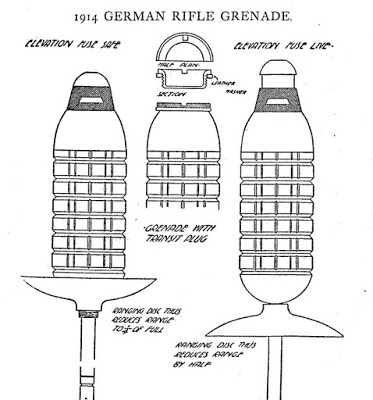


German rod grenades of 1913 and 1914 were impact/percussion fused designs of 2 lb weigh. Range was 350 yd for the 1913 and 380 yd for the 1914. Having entered service before the war, large numbers were available to German units. There were no safety pins, the designs being armed by the action of firing. They might also become live if dropped, especially on the tail rod. Live grenades might detonate when fired. Both models used 18 inch rods with a gas check. A tin disc could be fitted to the nose of the 1913 for firing at ranges of less than 200 yd. The 1914 had a saucer that was screwed between the grenade and the rod. Convex side forward this halved the range, concave side forward it quartered it.
The Germans were amply provided with rod grenades and made frequent use of them. At the start of the war they also enjoyed an advantage in trench mortars. The British soldiers were subjected to rains of bombs and grenades with no weapon that could counter them nor equivalent of their own.
Once they had their own models, the British also used rod grenades in considerable numbers. In July 1916, two reinforced companies from the Royal Welch Fusiliers expended thousands within a few hours. In August 1915, Field Marshal French (British Army) has asked to be supplied with 112,000 rifle grenades per week (actual supply raised to 19,000).
Allegedly, American soldiers with trap or skeet-shooting experience were provided with M97 Trench guns and placed in positions where they could fire on incoming rifle grenades.
There are very few examples of rodded grenades after the First World War.
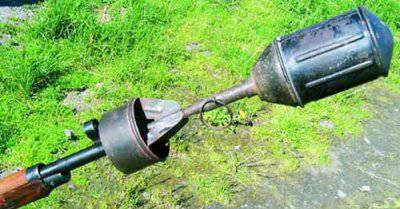
During the Second World War the Soviets used a hollow-charge rodded anti-tank grenade, the 60mm VPGS-41. It massed 1.5lb and had a range of 55 to 85 yards. It was only produced between Autumn 1941 and Spring 1942. Excellent source on Russian rifle grenades, including First World War models.
Some “anarchist” manuals describe shotguns (which may themselves be home-made) converted to grenade launch by using projectiles with dowel rods. The larger bore and other characteristics of shotguns permit construction methods different to the First World War grenades. This may be easier to improvise or manufacture than a cup discharger.
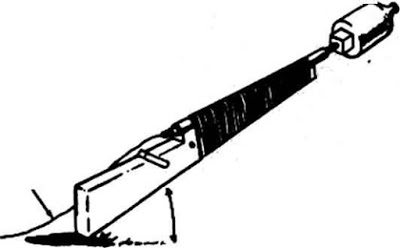

A company called Precision Ordinance produces the M444, a very long, narrow stun grenade that can be fitted down and launched to about 100 yd from a 12g shotgun barrel. It can also be pushed or thrown through small holes, such as those made by a shotgun damage.
Some mortars and artillery have used muzzle-loaded projectiles with rods that passed down the barrel.
The German 15cm heavy infantry gun (s.IG33) used a 200 lb Steilgranate 42 “stick bomb” with stabilizing fins that remained outside the barrel. This projected a warhead containing 60 lb of explosive to 1,100 yd and was used against strongpoints and wire obstacles.
Similar in design was the Steilgranate 41 fired by the 37mm PAK 36 anti-tank gun. This was a 19 lb shaped-charge projectile with 180mm penetration. Maximum range was 880 yd, although 330 yd was a more likely engagement range.
The Japanese Type 98 50mm mortar (not to be confused with the Type 89 50mm “knee mortar”) is another example.


GURPS High-Tech 3e describes TL4 rodded grenades. I do not know if there is a historical precedent for these. The greater bore-size of a musket allows the rod to be tube of powder. p.46: “Another kind of explosive is a rodded grenade. It can be fired from any smooth-bore shoulder gun. The rod is hollow, and filled with an incendiary compound to serve as a fuse. The rod is fitted down the barrel, and the gun fired – with a blank charge, of course! If all goes well, the powder charge both propels and ignites the grenade…Weapon stats for rodded or cup-launched grenades are different than for the same weapon with ball. Damage, as a projectile, is 1d. Explosive damage is normal for a TL4/5 grenade. Half-damage range is meaningless for a launched grenade; maximum range is 100. Accuracy is 2; Snap Shot is 10…A [TL4] rodded grenade can be picked up and thrown, if it does not explode – but the fuse cannot be extinguished. On a misfire of the launching weapon, the fuse of a rodded grenade does not ignite.”